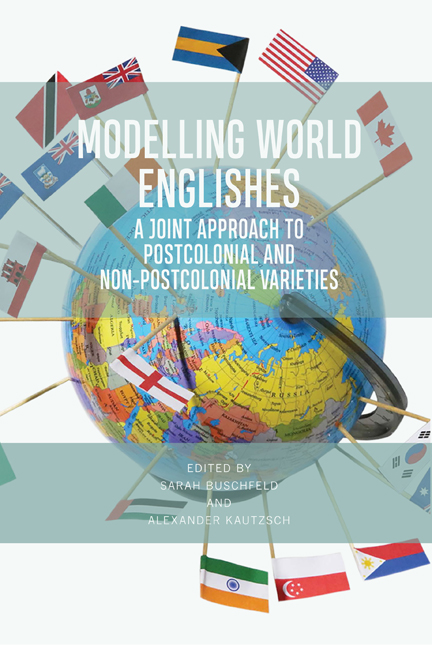Book contents
- Frontmatter
- Contents
- List of Figures and Tables
- List of Contributors
- Foreword
- 1 Introduction
- 2 English in England: The Parent Perspective
- 3 English in Namibia: Multilingualism and Ethnic Variation in the Extra- and Intra-territorial Forces Model
- 4 English in the United Arab Emirates: Status and Functions
- 5 English in India: Global Aspirations, Local Identities at the Grassroots
- 6 English in Singapore: Two Issues for the EIF Model
- 7 English in the Philippines: A Case of Rootedness and Routedness
- 8 English in South Korea: Applying the EIF Model
- 9 English in Japan: The Applicability of the EIF Model
- 10 English in Australia – Extra-territorial Influences
- 11 English in North America: Accounting for its Evolution
- 12 English in The Bahamas and Developmental Models of World Englishes: A Critical Analysis
- 13 Standard English in Trinidad: Multinormativity, Translocality, and Implications for the Dynamic Model and the EIF Model
- 14 Englishes in Tristan da Cunha, St Helena, Bermuda and the Falkland Islands: PCE, non-PCE or both? Blurred Boundaries in the Atlantic
- 15 English in Ireland: Intra-territorial Perspectives on Language Contact
- 16 English in Gibraltar: Applying the EIF Model to English in Non-Postcolonial Overseas Territories
- 17 English in Ghana: Extra- and Intra-territorial Forces in a Developmental Perspective
- 18 Synopsis: Fine-tuning the EIF Model
- Index
12 - English in The Bahamas and Developmental Models of World Englishes: A Critical Analysis
Published online by Cambridge University Press: 24 September 2020
- Frontmatter
- Contents
- List of Figures and Tables
- List of Contributors
- Foreword
- 1 Introduction
- 2 English in England: The Parent Perspective
- 3 English in Namibia: Multilingualism and Ethnic Variation in the Extra- and Intra-territorial Forces Model
- 4 English in the United Arab Emirates: Status and Functions
- 5 English in India: Global Aspirations, Local Identities at the Grassroots
- 6 English in Singapore: Two Issues for the EIF Model
- 7 English in the Philippines: A Case of Rootedness and Routedness
- 8 English in South Korea: Applying the EIF Model
- 9 English in Japan: The Applicability of the EIF Model
- 10 English in Australia – Extra-territorial Influences
- 11 English in North America: Accounting for its Evolution
- 12 English in The Bahamas and Developmental Models of World Englishes: A Critical Analysis
- 13 Standard English in Trinidad: Multinormativity, Translocality, and Implications for the Dynamic Model and the EIF Model
- 14 Englishes in Tristan da Cunha, St Helena, Bermuda and the Falkland Islands: PCE, non-PCE or both? Blurred Boundaries in the Atlantic
- 15 English in Ireland: Intra-territorial Perspectives on Language Contact
- 16 English in Gibraltar: Applying the EIF Model to English in Non-Postcolonial Overseas Territories
- 17 English in Ghana: Extra- and Intra-territorial Forces in a Developmental Perspective
- 18 Synopsis: Fine-tuning the EIF Model
- Index
Summary
INTRODUCTION
Modeling Englishes has enjoyed quite some popularity since the late 1980s, when the focus of research shifted from the description of individual varieties to attempts at explaining the entire “English Language Complex” (Mesthrie and Bhatt 2008: 3). One of the most influential models which has emerged in this context is Schneider's (2003, 2007) Dynamic Model, which, in essence, claims that “it is possible to identify a single, underlying, fundamentally uniform evolutionary process which can be observed, with modifications and adjustments to local circumstances, in the evolution of all postcolonial forms of English” (Schneider 2017: 47). The realities of the twenty-first century, and primarily globalization and web-based communication, have dramatically altered the ways English is used around the world and have accelerated the diversification of the language. Schneider himself (2014: 28) draws attention to the limitations of the Dynamic Model in accounting for “this new kind of dynamism of global Englishes.”
It is the explicit aim of Buschfeld and Kautzsch's “Extra- and Intraterritorial Forces” (EIF) Model to account for these “complex linguistic realities” (2017: 104). The EIF Model's basic assumption is that all Englishes have been shaped by a set of “forces,” which can be divided into external (“extra-territorial”) and internal (“intra-territorial”) ones. These forces are viewed as “general mechanisms” affecting the development of any specific variety, the difference lying in the “concrete form” that they assume (2017: 116). This permits a unified treatment not only of postcolonial and non-postcolonial Englishes but also of the colonial and postcolonial periods for the former: “intra- and extra-territorial forces have always been the driving forces behind the (socio)linguistic developments in the territories throughout the process of colonization but also in postcolonial times” (2017: 116). The EIF Model builds on the basic components and assumptions of the Dynamic Model but integrates them in a “higher-level framework” (2017: 111), so that “all aspects of the model, most importantly the five phases and the four parameters operating on them, can be explained in terms of such extra- and intraterritorial forces” (2017: 116).
- Type
- Chapter
- Information
- Modelling World EnglishesA Joint Approach to Postcolonial and Non-Postcolonial Varieties, pp. 251 - 273Publisher: Edinburgh University PressPrint publication year: 2020

